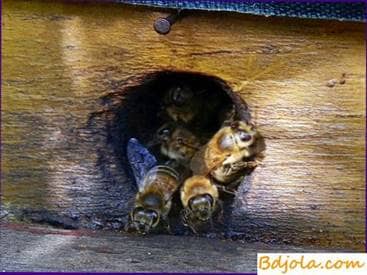
The “Dictionary-Directory of the Beekeeper” contains the basic rules for regulating the width of the tap, depending on the season, the weather conditions, the strength of families, etc., which are as follows.
After flying around the family, the checkers are kept tapered to 1-3 cm (depending on its strength). As it develops and the flight activity of bees increases, the gap of the flight gap is reduced to 4-6 cm. By the time of digestion, the lower flaps are gradually opening to the full width, for the time of the main honey pick, the lower, upper and side flaps open completely, and after its completion all additional tapholes close. The lower ones are kept narrowed just like in the spring.
These rules I strictly adhered to when I started beekeeping, that is, almost two decades ago. However, he noticed that when the width of the tap was 3 or even 5 cm (at a height of the gap of 7 mm), the families were very noisy, ventilating the nest, and because of temperature changes (at night, frosts to -7 њ C, during the day thaw to 5 SS) condensed moisture, which drained along the walls of the hive and the sloping floor to the tap.
Because of this, a part of the bees perished. I had to make a test insert with a cutout of 7X200 mm, which was covered up to half by a bookmark from the newspaper. The noise decreased slightly, but the condensation of moisture remained almost the same. We had to take out a bookmark and a liner every morning, wipe the bottom, and sometimes for one or two hours leave the tray completely open to dry and air the bottom of the hive.
Once in the spring I forgot to put a liner and a bookmark in one of the hives. At night, they froze to 10 њ C, and in the morning, to my surprise, I found out that the family was very quiet. There was no moisture and no spoiling, and through the summer we can see that the bees are alive and completely cover the streets from the bottom. Deciding that this regime is favorable to bees, I fully opened the tapholes (20X375 mm) and the rest of the hives. After three weeks, when setting up the second buildings, I examined the nests and established that everywhere there is brood and it starts from the very bottom of the frame, that is, it is formed in the lowest temperature part of the nest.
He reduced the tapholes with the aid of the liner only after the main honey collection and the bees replenish the stern reserves for the winter. When the years had almost ceased, he inserted a newspaper bookmark, reducing the length of the leaf to 10 cm. If you do not cut the outlets in the impotent period, the bees themselves will begin to pre-polish it. In addition, the occurrence of bee theft.
After the formation of a permanent club (approximately in the middle of November) again completely opened the lower tapholes and installed barriers from mice. In the middle of December, when the families moved to the second (aft) building, he opened the upper tapholes and limited them to a bushing with a hole of 4X10 mm. In this situation, the flocks of the family successfully hibernate for more than six months at will, despite the severe temperature conditions (frosts sometimes reach -40 њ C, alternating with sharp thaws). This method of keeping bees I have been applying for the fifteenth year and I consider it to be optimal.
My apiary is located on the Karelian Isthmus. I keep families in multi-hive beehives. Bee bees: a “wet” seal coexists with “dry” even on one honeycomb. Families are all year round at a fixed point and winter in two buildings. Hives do not fall asleep with snow. They are protected from precipitation and wind by canvas covers, the lower edge of which is lowered 5-10 cm below the main tap. At the level of the upper tap in the tarpaulin a hole is made. Cases on the hives are pulled together with twine with elastic bands.
In late March – early April, on a sunny, calm day at a temperature in the shade of 8-10 њ C, bees make an early flight. At this time, snow still lies all around, until next spring another month, and you can not wait and lose time. At the same time I change the dona, I reduce the nests to one body and replenish the fodder reserves. Loss of bees at such a flight is inevitable, but they make up no more than 5-10% and pay off with the early development of families. In the future, I keep the families according to the adopted method for multi-hull beehives. Long-term experience of keeping bees with the regulation of the size of the taphole allows me to successfully carry out the wintering of bees at will, to have strong families (in four buildings) to the main honey collector and to receive 30-50 kg of commodity honey at a poor fodder base.
Торт идеалы с медом. Торт на меду идеал.
Fixtures and fixtures